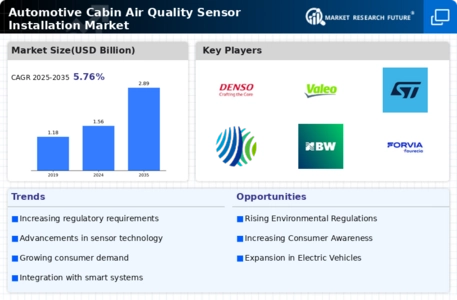Major players in Automotive Cabin Air Quality Sensor Installation Market industry are constantly striving to maintain competitive advantage. Leading Automotive Cabin Air Quality Sensor Installation Market players are focusing on developing innovative technologies to improve the accuracy and reliability of their products. They are also investing in research and development to enhance the efficiency and performance of their products. The Automotive Cabin Air Quality Sensor Installation Market is characterized by intense competition, with leading players like Continental, Denso, Delphi, and Valeo vying for market share. These companies are known for their advanced technologies, global reach, and strong distribution networks.
To stay ahead of the competition, these companies are constantly investing in research and development, product innovation, and strategic partnerships. The Automotive Cabin Air Quality Sensor Installation Market is also witnessing the emergence of new players who are challenging established players with their innovative offerings. These new entrants are leveraging technological advancements and cost-effective manufacturing processes to gain a foothold in the market.
Continental is a leading player in the Automotive Cabin Air Quality Sensor Installation Market. With a focus on innovation, Continental has developed a wide range of cabin air quality sensor installation solutions that meet the needs of automakers. Continental's products are known for their high accuracy, reliability, and durability. The company's global presence and strong distribution network enable it to reach customers in various regions. Continental is also investing in research and development to enhance the features and capabilities of its products.
A competitor to Continental in the Automotive Cabin Air Quality Sensor Installation Market is Denso. Denso is a global supplier of automotive components and systems. The company has a strong presence in the cabin air quality sensor installation market, offering a comprehensive range of products. Denso's products are known for their high quality, performance, and reliability. The company's global reach and strong distribution network enable it to serve customers in various regions. Denso is investing in research and development to expand its product portfolio and improve the capabilities of its products.
The company's commitment to innovation and technological advancements makes it a formidable competitor in the market.





















Leave a Comment